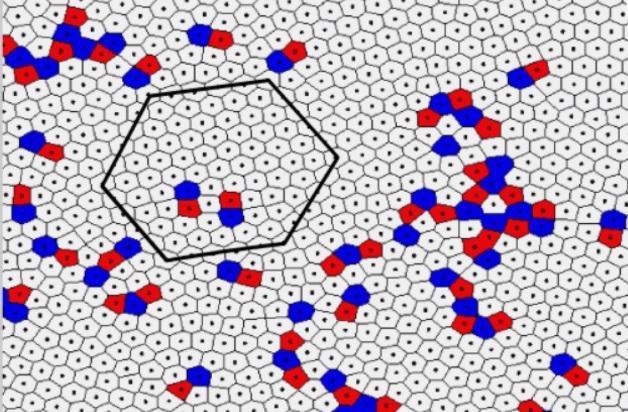Jan 20 2021
Researchers at the Joint Institute for High Temperatures Russian Academy of Sciences (JIHT RAS) and Moscow Institute of Physics and Technology (MIPT) have experimentally validated the existence of an intermediate phase between the liquid and crystalline states in a monolayer dusty plasma system.
 Intermediate phase illustration. Image Credit: Scientific Reports.
Intermediate phase illustration. Image Credit: Scientific Reports.
The Nobel Prize in Physics in 2016 was awarded for the theoretical prediction of the intermediate—hexatic—phase to Michael Kosterlitz, David Thouless, and Duncan Haldane with the formulation “for theoretical discoveries of topological phase transitions and topological phases of matter.”
In a study published in the Scientific Reports journal, the JIHT RAS researchers have reported their observations and comprehensive descriptions of experiments, that helped first observe the hexatic phase in two-dimensional structures in plasma.
The study describes techniques for the precise determination of phase transition points and offers a comprehensive analysis of the structural properties of such a system. The data acquired from the experiment are completely in tandem with the Berezinsky-Kosterlitz-Thouless theory.
Our design of experiment makes it possible to clearly observe a two-stage process of crystal melting and to identify the points of the phase transition ‘solid-hexatic phase’ and ‘hexatic phase-liquid’.
Elena Vasilieva, PhD, Senior Researcher, Laboratory of Dusty Plasma Diagnostics, Joint Institute for High Temperatures Russian Academy of Sciences
“The long time of the experiment, sufficient to establish a stationary state of the system, in combination with precise methods of controlling the temperature of particles, made it possible to smoothly change the parameters of the system and ‘catch’ the hexatic phase,” added Vasilieva.
Elena Vasilieva further explained that although the Berezinsky-Kosterlitz-Thouless theory, which predicts the formation of an intermediate hexatic phase during the two-stage melting from a crystal to a liquid phase, has existed for over four decades, it has been impossible to date to analyze these processes in laboratory plasma systems.
Although researchers have already observed two-dimensional transitions in liquid crystals, polymer colloids, magnetic bubbles in thin films, and superconductors, experimental evidence of two-stage melting in dusty plasmas has been lacking for a long time.
Our experiment was successful due to a number of factors. For example, we used an unconventional approach to form a monolayer dusty system, namely we used particles with a metal surface that are capable of absorbing laser radiation and converting it into the energy of their own motion.
Oleg Petrov, Director, Joint Institute for High Temperatures Russian Academy of Sciences
“The particle system had a long time for relaxation before recording the experimental series. In addition, a homogeneous laser beam was used to uniformly influence the structure and its precise heating,” added Petrov.
It is of immense practical significance to analyze the physical properties of two-dimensional systems. Such studies are now developing fast, paving the way for new materials with preferred properties and devices based on them in microelectronics, medicine for DNA sequencing, etc. in the future.
The findings described in the article were acquired with the support of the Russian Science Foundation in the framework of the project “Active Brownian motion of Coulomb particles in plasma and superfluid helium.”
Journal Reference:
Vasilieva, E. V., et al. (2021) Laser-induced melting of two-dimensional dusty plasma system in RF discharge. Scientific Reports. doi.org/10.1038/s41598-020-80082-x.